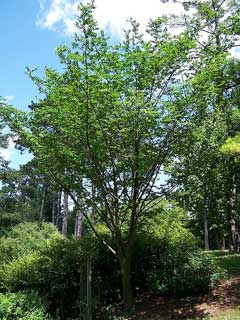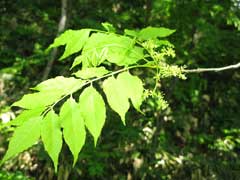 |
|
http://commons.wikimedia.org/wiki/User:Bruce_MarlinPicris echioides |
 |
| http://commons.wikimedia.org/wiki/User:Qwert1234 |
Translate this page:
Summary
Physical Characteristics

 Picrasma quassioides is a deciduous Tree growing to 10 m (32ft) by 7 m (23ft).
Picrasma quassioides is a deciduous Tree growing to 10 m (32ft) by 7 m (23ft).
See above for USDA hardiness. It is hardy to UK zone 6. It is in flower in May, and the seeds ripen in October. The species is hermaphrodite (has both male and female organs).
Suitable for: light (sandy), medium (loamy) and heavy (clay) soils. Suitable pH: mildly acid, neutral and basic (mildly alkaline) soils. It can grow in semi-shade (light woodland) or no shade. It prefers moist soil.
UK Hardiness Map
US Hardiness Map
Synonyms
Plant Habitats
Woodland Garden Secondary; Sunny Edge;
Edible Uses
Edible Parts: Fruit
Edible Uses: Condiment Tea
Fruit[105, 177]. Small and red[183]. The fruit is a berry about 7mm in diameter[200]. Young buds (the report does not say if they are flower or leaf buds) are used to make a tea[177, 179, 183]. A bitter substance called quassin' is extracted from (the bark of?) the tree and can be used as a hop substitute in brewing beer[183].
References More on Edible Uses
Medicinal Uses
Plants For A Future can not take any responsibility for any adverse effects from the use of plants. Always seek advice from a professional before using a plant medicinally.
Anthelmintic Antiviral Bitter Febrifuge Hypotensive Parasiticide Stomachic Tonic
The wood contains a number of medicinal compounds and has been shown to be anthelmintic, antiamoebal, antiviral, bitter, hypotensive and stomachic[279]. It increases the flow of gastric juices[279]. It is used in Korea in the treatment of digestive problems, especially chronic dyspepsia[279]. A decoction of the stem bark is bitter, febrifuge and tonic[46, 61, 146, 158, 174, 218, 240, 272]. The leaves have been used to treat itchy skins[240, 272]. (Probably acting by killing body parasites[K].
References More on Medicinal Uses
The Bookshop: Edible Plant Books
Our Latest books on Perennial Plants For Food Forests and Permaculture Gardens in paperback or digital formats.

Edible Tropical Plants
Food Forest Plants for Hotter Conditions: 250+ Plants For Tropical Food Forests & Permaculture Gardens.
More

Edible Temperate Plants
Plants for Your Food Forest: 500 Plants for Temperate Food Forests & Permaculture Gardens.
More

More Books
PFAF have eight books available in paperback and digital formats. Browse the shop for more information.
Shop Now
Other Uses
Insecticide Parasiticide Wood
The bark is used as an insecticide[46, 61]. Another report says that it is the wood that is used[240]. It is a substitute for the insecticide quassia, which is obtained from the wood of a tropical tree[240]. Quassia is a relatively safe organic insecticide that breaks down quickly and is of low toxicity to mammals. It has been used as a parasiticide to get rid of lice, fleas etc. Wood - hard, fine and close grained. Used for mosaic, utensils etc[46, 61, 158].
Special Uses
References More on Other Uses
Cultivation details
Requires a fertile humus-rich moisture-retentive loam in a sunny position[200]. Plants also succeed when growing in semi-shade[188]. According to [200] this plant is only hardy to zone 10 (not tolerating frosts) but there are healthy trees in many parts of Britain including one 8.5 metres tall at Kew in 1981, one 8 metres tall seen growing in light woodland shade at Cambridge Botanical Gardens where it was bearing fruit in the autumn of 1996 and one 9 metres tall at Westonbirt in 1980[11, K].
References Carbon Farming Information and Carbon Sequestration Information
Temperature Converter
Type a value in the Celsius field to convert the value to Fahrenheit:
Fahrenheit:
The PFAF Bookshop
Plants For A Future have a number of books available in paperback and digital form. Book titles include Edible Plants, Edible Perennials, Edible Trees,Edible Shrubs, Woodland Gardening, and Temperate Food Forest Plants. Our new book is Food Forest Plants For Hotter Conditions (Tropical and Sub-Tropical).
Shop Now
Plant Propagation
Seed - best sown as soon as it is ripe in a cold frame. Stored seed requires 3 months cold stratification[113] and should be sown as early in the year as possible. When they are large enough to handle, prick the seedlings out into individual pots and grow them on in the greenhouse for at least their first winter. Plant them out into their permanent positions in late spring or early summer, after the last expected frosts. Cuttings of half-ripe wood, July/August in a frame[200]. Root cuttings 4cm long in December. Plant them out horizontally in pots in a greenhouse[78].
Other Names
If available other names are mentioned here
Native Range
TEMPERATE ASIA: China (Hebei Sheng, Hubei Sheng (south), Sichuan Sheng, Yunnan Sheng), Korea, Japan (Hokkaidô, Honshu, Kyushu, Ryukyu Islands, Shikoku), Taiwan TROPICAL ASIA: Bhutan, India (Assam, Himachal Pradesh, Jammu and Kashmir, Meghalaya, Nagaland, Punjab, Uttar Pradesh, Arunachal Pradesh), Nepal
Weed Potential
Right plant wrong place. We are currently updating this section.
Please note that a plant may be invasive in one area but may not in your area so it's worth checking.
Conservation Status
IUCN Red List of Threatened Plants Status :

Growth: S = slow M = medium F = fast. Soil: L = light (sandy) M = medium H = heavy (clay). pH: A = acid N = neutral B = basic (alkaline). Shade: F = full shade S = semi-shade N = no shade. Moisture: D = dry M = Moist We = wet Wa = water.
Now available:
Food Forest Plants for Mediterranean Conditions
350+ Perennial Plants For Mediterranean and Drier Food Forests and Permaculture Gardens.
[Paperback and eBook]
This is the third in Plants For A Future's series of plant guides for food forests tailored to
specific climate zones. Following volumes on temperate and tropical ecosystems, this book focuses
on species suited to Mediterranean conditions—regions with hot, dry summers and cool, wet winters,
often facing the added challenge of climate change.
Read More
Expert comment
Author
(D.Don.)Benn.
Botanical References
1158
Links / References
For a list of references used on this page please go here
Readers comment
© 2010, Plants For A Future. Plants For A Future is a charitable company limited by guarantee, registered in England and Wales. Charity No. 1057719, Company No. 3204567.